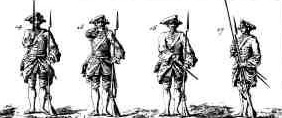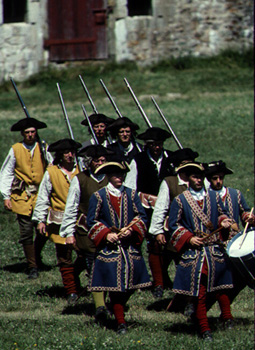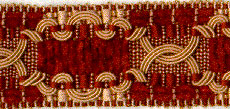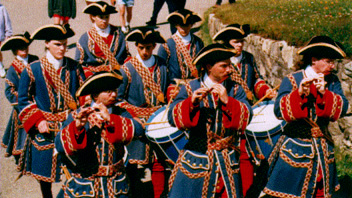
LCFMarine
Website Design and Content © 2004 by Eric
Krause, Krause House Info-Research Solutions (© 1996)
All Images ©
Parks Canada Unless Otherwise Designated
Researching the
Fortress of Louisbourg National Historic Site of Canada
Recherche sur la Forteresse-de-Louisbourg Lieu historique national du Canada
Compagnies Franches De La Marine Site

THE DRUMMERS OF LOUISBOURG
In 1757 Marshal Saxe of France observed that there was nothing "more common, than to see a number of persons dance together during a whole night, even with pleasure; but, deprive them of music, and the most indefatigable amongst them, will not be able to bear it for two hours only; which sufficiently proves, that sounds have a secret power over us, disposing our organs to bodily exercise, and, at the same time, deluding, as it were, the toil of them."
The usefulness of music in ordering the movement of large numbers of men while lessening the drudgery attached to such movement has been long known to the military of all nations. It is difficult for anyone to remain unmoved by a martial air performed by a marching band. But while fifes, horns or bagpipes may provide the melody which lingers in our heads long after the band has passed, it is the drum with its solid tone, audible above all other sounds, which regulated the movement of our feet. Even those with no ear for music respond to its persistent beat. As Saxe noted, the movement is "so natural, that it can hardly be...avoided". He noticed "in beating to arms, the soldiers have fallen into their ranks in cadence, without being sensible to it...nature and instinct carrying them involuntarily...".
Brought to Europe by the Turks during their invasion of the continent in the middle
ages, the drum first appeared in France when the English army under Edward III captured
Calais in 1347. Before long the drum was adopted for use in the French army. In describing
the usefulness of the  drum Thoinot
Arbeau, a 16th
century dance master, declared that "if three men are walking together and each
wishes to go at a different rate...they will not be in step...That is why, in a military
march, the French have employed a drum to beat the rhythm according to which the soldiers
must march..."
drum Thoinot
Arbeau, a 16th
century dance master, declared that "if three men are walking together and each
wishes to go at a different rate...they will not be in step...That is why, in a military
march, the French have employed a drum to beat the rhythm according to which the soldiers
must march..."
However, it was not only in the march that the drum proved useful to the military. Since its sound travelled far and could be heard despite other noises, the drum became "the very tongue and voice of the Commander ..." as he issued orders to his troops whether on the march, in camp or in garrison. Within the army of each country a series of beats evolved which conveyed instructions to the soldiers from their officers. A drummer had to be able to perform each of these calls with precision. An error, particularly on the field of battle, could result in utter confusion, panic or even defeat. Since some calls had more than one meaning, depending on when it was beaten, each soldier had to be able to recognize not only the call itself, but what it meant at a particular time. Drummers were expected to learn the calls employed by rival armies so that they might keep their officers informed of the enemy's movements.
When a troop was in garrison in a fortress or town, it was not only the soldiers who were affected by the drum calls. Civilians residing in the area soon found their lives regulated to a degree by the same calls. They, like the soldiers, would be awakened by the sound of reveille. They would know when the town gates were being opened or closed to traffic, when special announcements were to be made, or when they were expected to carry a lantern on the streets or face arrest. Even calls which applied only to the military served, because they were part of a prescribed routine, to notify their civilian neighbours of the time of day.
The importance of the drum as a means of communication gave a certain prominence to those who played it. Drummers usually received a higher rate of pay than their fellow soldiers, were often lodged separately in less crowded quarters, and were able to avoid some of the more tiresome duties of soldiers. The most visible sign of his special status was the drummer's colourful uniform. It was important for a commander to be able to spot his drummer easily. For this reason the drummer wore a uniform, often elaborately trimmed, which would easily distinguish him from the body of the troops. While undoubtedly a source of pride to its wearer, this uniform could prove a disadvantage in battle. What better way to throw the opposing force into chaos than to prevent it from receiving its orders. When the "voice" of the commander, unarmed and easily visible, was silenced, the advantage belonged to the enemy.

The troops stationed at Louisbourg prior to 1745 belonged, for the most part to the Compagnies Franches De La Marine ln 1744 there were eight companies in Louisbourg, each containing two drummers. Though such companies stationed in France also included a fifer in their ranks, there was only one fifer in Louisbourg to serve all eight companies. The Compagnies Franches also had a drum major. Picked from among the sergeants the drum major was responsible for the drummers in the same way as sergeant was for his company. During the years before the first siege, Louisbourg's drummers were paid as ordinary soldiers (This was changed while the troops were in France between 1745 and 1748, and the drummers who returned to Louisbourg received a higher rate of pay). They did have separate living quarters, however, and their uniform, trimmed with the livery of the king, must have helped them feel like part of an elite corps.
There were also four drummers and a fifer at Louisbourg who were members of the Karrer
Regiment, a mercenary unit in the service of France which was commanded by a Swiss
colonel, Franz Adam Karrer. Their uniform of red and yellow, trimmed with their Colonel's
livery would have been even more striking than the one worn by the Compagnies
Franches.
During the years the detachment of the Karrer
Regiment was in Louisbourg numerous disputes arose between its commanders and the
authorities of the colony of Ile Royale. It is interesting to note that several of these
arguments involved the drummers and what or when they would beat.
the detachment of the Karrer
Regiment was in Louisbourg numerous disputes arose between its commanders and the
authorities of the colony of Ile Royale. It is interesting to note that several of these
arguments involved the drummers and what or when they would beat.
One additional drummer was attached to Louisbourg's only artillery company, authorized in 1743. Members of this company wore the same colours as the drummers of the Compagnies Franches - red pant-socks and vests, with a blue coat trimmed with red, the trim on the drummers' coats setting them apart. The drummer of the artillery company wore red and blue also but the colours were reversed. His coat too carried the livery of the king.
It is evident from the ratio of drummers to fifers (21 to 2) that, at Louisbourg, the fifer and his melodies were of little importance. An observer, writing in the 17th century, stated that the fife was "only an instrument of pleasure...and it is to the voice of the Drummer the soldier should wholly attend..." Certainly at Louisbourg this was the case. Nothing is known of the duties of the two who were stationed there. Their use was probably largely ceremonial or at least confined to occasions when the massed drummers were called to perform.
The drums in use during the mid-18th century were rope-tension snare drums of oak or walnut Usually as high as they were wide, the drums did not exceed 30 inches (75 centimeters) due to the difficulty of finding skins large enough to use as drum heads. Calf, goat or sheep skins could be used. These skins became limp in dampness making the proper execution of rolls very difficult. The drums ordered for the Compagnies Franches at Louisbourg were painted blue and sprinkled with gold fleurs-de-lys. They had two catgut snares and heads made from goat skins rather than the preferred sheep.